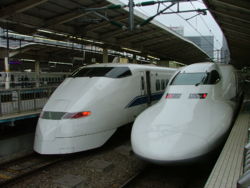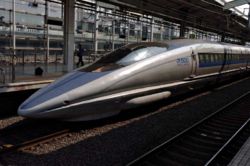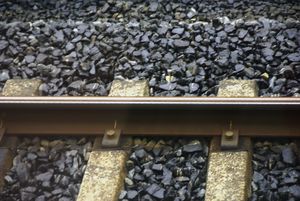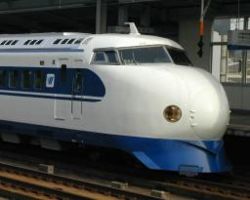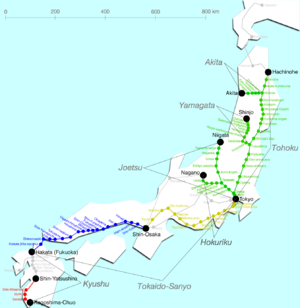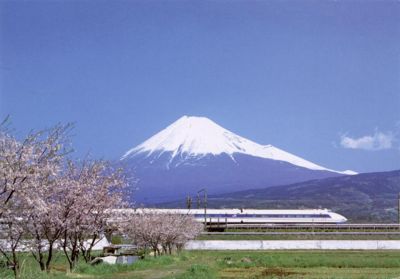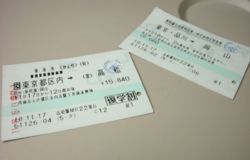Shinkansen
The Shinkansen (新幹線?) is a network of high-speed railway lines in Japan operated by Japan Railways. Since the initial Tōkaidō Shinkansen opened in 1964, the network has expanded to link most major cities on the islands of Honshū and Kyūshū with running speeds of up to 300 km/h (186 mph), in an earthquake and typhoon prone environment. Test run speeds have been 443 km/h (275 mph) for conventional rail, and up to 580 km/h (360 mph) for maglev trainsets.
Shinkansen literally means "New Trunk Line" and hence strictly speaking refers only to the tracks, while the trains themselves are officially referred to as "Super Express" (超特急 chō-tokkyū); however, this distinction is rarely made even in Japan. In contrast to older lines, Shinkansen are standard gauge, and use tunnels and viaducts to go through and over obstacles, rather than around them.
Contents
History
Japan was the first country to build dedicated railway lines for high speed travel. Due to mountainous terrain, the pre-existing network consisted of 1,067 mm (3 ft 6 in) narrow gauge lines, which generally took indirect routes and could not be adapted to higher speeds. Consequently, Japan had a greater need for new high speed lines than countries where the existing standard gauge or broad gauge rail system had more upgrade potential.
Early proposals
The popular English name The bullet train is a Western translation of the Japanese term dangan ressha (弾丸列車), a nickname given to the project while it was initially being discussed in the 1930s. The name stuck due to the Shinkansen locomotive's resemblance to a bullet and its high speed.
The "Shinkansen" name was first formally used in 1940 for a proposed standard gauge passenger/freight line between Tokyo and Shimonoseki, using steam and electric locomotives with a top speed of 200 km/h (twice the speed of the fastest existing Japanese train). Over the next three years, the Ministry of Railways drew up more ambitious plans to extend the line to Beijing (through a tunnel to Korea) and even Singapore, and build connections to the Trans-Siberian Railway and other trunk lines in Asia. These plans were abandoned in 1943, as Japan's position in World War II began to erode. However, some construction did commence on the line; several tunnels on the present-day Shinkansen date to the war-era project.
Construction
Following Japan's defeat in 1945, high speed rail was forgotten for several years. By the mid-1950's, the Tōkaidō Main Line was operating at full capacity, and the Ministry of Railways decided to revisit the Shinkansen project. Government approval came in 1958, and construction of the first segment of the Tōkaidō Shinkansen between Tokyo and Osaka started in 1959. Much of the construction was financed by a US$80 million loan from the World Bank. A testing facility for rolling stock, now part of the line, opened in Odawara in 1962.
The Tōkaidō Shinkansen opened on October 11964, in time for the Tokyo Olympics. It was an immediate success, reaching the 100 million passenger mark in less than three years on July 131967 and one billion passengers in 1976. Sixteen-car trains were introduced for Expo '70 in Osaka.
The first Shinkansen trains ran at speeds of up to 210 km/h (130 mph)[1], later increased to 220 km/h (135 mph). Some of these trains, with their classic bullet-nosed appearance, are still in use. A driving car from one of the original trains is now in the British National Railway Museum in York.
Network expansion
This early success prompted an extension of the first line westward to Hiroshima and Fukuoka (the Sanyo Shinkansen), and was completed in 1975.
Prime Minister Kakuei Tanaka was an ardent supporter, and his government proposed an extensive network paralleling most existing trunk lines. Two new lines, the Tohoku Shinkansen and Joetsu Shinkansen, were built following this plan. Many other planned lines were delayed or scrapped entirely as the national railway went further into debt, largely due to the high costs of building the Shinkansen network. By the early 1980's, Japan National Railways was practically insolvent, leading to privatization in 1987.
Despite this situation, development of the Shinkansen continued. Many further models of train followed the first, generally each with its own distinctive appearance. Shinkansen trains now run regularly at speeds of up to 300 km/h (186 mph), putting them among the fastest trains running in the world, along with the French TGV Eurostar Thalys, Italian TAV, Spanish AVE, German ICE, and South Korean KTX trains.
Since 1970 development has also been underway for the Chūō Shinkansen, a maglev train planned to run from Tokyo to Osaka. On December 22003, the 3 car maglev trainset reached a world speed record of 581 km/h (361 mph).
In 2003 JR Central reported that the Shinkansen's average arrival time was within 0.1 minutes or 6 seconds of the scheduled time. This includes all natural and human accidents and errors and is calculated from all of about 160,000 trips Shinkansen made. The previous record was from 1997 and was 0.3 minutes or 18 seconds. Japan celebrated 40 years of high speed rail in 2004, with the Tōkaidō Shinkansen line alone having carried 4.16 billion passengers. According to Japanrail.com, the network has carried over 6 billion passengers.
Safety record
There have been no passenger fatalities due to derailments or collisions during operation of the Shinkansen. Injuries and a single fatality have been caused by doors closing on passengers or their belongings. Attendants are at platforms to prevent this.
There have been suicides by passengers jumping both from and in front of moving trains. This has resulted in some stations installing barriers preventing passengers from accessing the tracks, although an incident on January 9, 1999 at Sakudaira Station on the Nagano Shinkansen showed that even these would not stop determined suicides. A man climbed a safety barrier and was hit by a non-stop service.
The only derailment of a Shinkansen train in passenger service occurred during the Chūetsu Earthquake on October 23, 2004. Eight of ten cars of the Toki No. 325 train on the Jōetsu Shinkansen derailed near Nagaoka Station in Nagaoka, Niigata. However, there were no injuries or deaths among the 154 passengers. [2] In the event of an earthquake, an earthquake detection system can bring the train to a stop very quickly. The next generation FASTECH 360 trains will have ear-like air resistance braking flaps to assist emergency stops at high speeds.
Future
Due to noise pollution concerns, increasing speed is becoming more difficult. Current research is primarily aimed at reducing operational noise, particularly the "tunnel boom" phenomenon caused when trains enter tunnels at high speed. Despite this, there are two planned speed increases, one to 350 km/h (217 mph) for new trains on the Sanyō line, and one to 360 km/h (223 mph) using derivatives of the FASTECH 360 trains currently being tested on the Tōhoku Shinkansen.
The Kyūshū Shinkansen from Kagoshima to Yatsushiro opened in March 2004. Three more extensions are planned for opening by 2010: Hakata-Yatsushiro, Hachinohe-Aomori, and by 2014: Nagano-Kanazawa. There are also long-term plans to extend the network, Hokkaidō Shinkansen from Aomori to Sapporo (through the Seikan Tunnel), Kyūshū Shinkansen to Nagasaki, and as well as complete a link from Kanazawa back to Osaka, although none of these are likely to be completed by 2020.
The Narita Shinkansen project to connect Tokyo to Narita International Airport, initiated in the 1970s but halted in 1983 after landowner protests, has been officially cancelled and removed from the Basic Plan governing Shinkansen construction. Parts of its planned right-of-way will be utilized by the Narita Rapid Railway link when it opens in 2010. Although the NRR will use standard gauge track, it will not be built to Shinkansen specifications and it would not be feasible to convert it into a full Shinkansen line.
List of Shinkansen lines
The main Shinkansen lines are:
- Tōkaidō Shinkansen (Tokyo – Shin-Osaka)
- Sanyō Shinkansen (Shin-Osaka – Hakata)
- Tōhoku Shinkansen (Tokyo – Hachinohe)
- Jōetsu Shinkansen (Ōmiya – Niigata)
- Hokuriku Shinkansen or Nagano Shinkansen (Takasaki – Nagano)
- Kyūshū Shinkansen (Shin-Yatsushiro – Kagoshima-Chūō)
Two further lines, known as Mini-Shinkansen (ミニ新幹線), have also been constructed by upgrading existing sections of line:
There are two standard gauge not technically classified as Shinkansen lines but with Shinkansen services:
- Hakata Minami Line (Hakata – Hakata-Minami)
- Gala-Yuzawa Line – technically a branch of the Jōetsu Line – (Echigo-Yuzawa – Gala-Yuzawa)
Future lines
Many Shinkansen lines were proposed during the boom of the early 1970s but have yet to be constructed. These are called Seibi Shinkansen (整備新幹線) or "planned Shinkansen." One of these lines, the Narita Shinkansen to Narita Airport, has been officially cancelled, but a few remain under development.
- Tōhoku Shinkansen extension from Hachinohe Station to Shin-Aomori is under construction and will open by 2010.
- Hokuriku Shinkansen extension to Kanazawa is under construction and will open by 2014. The complete extension of the line to Osaka is under development, and only Fukui Station is under construction.
- Kyūshū Shinkansen extension to Hakata is under construction and will open by 2010.
- The second Kyūshū Shinkansen route from Shin-Tosu to Nagasaki section is under development.
- The Hokkaidō Shinkansen from Shin-Aomori to Shin-Hakodate is under construction and will open by 2015. A further extension of the line from Shin-Hakodate to Sapporo is under development.
Shinkansen technology outside Japan
Railways using Shinkansen technology are not limited to those in Japan.
Taiwan High Speed Rail operates 700T Series sets built by Kawasaki Heavy Industries. China has ordered 60 eight-car 200 km/h EMUs based on the E2-1000 Series design built by a consortium formed of Kawasaki Heavy Industries, Mitsubishi Electric Corporation, and Hitachi, for deliveries starting in March 2006. For the Channel Tunnel Rail Link, Hitachi-built EMUs based on Shinkansen technology will be exported for use on high-speed commuter services in Britain.
List of Shinkansen train models
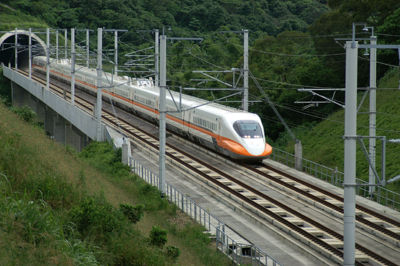
Trains can be up to sixteen cars long. With each car measuring 25 m (82 ft) in length, the longest trains are 400 m (1/4 mile) from front to back. Stations are similarly long to accommodate these trains.
- Passenger Trains
- 0 Series
- 100 Series
- 200 Series
- 300 Series
- 400 Series (Mini-Shinkansen)
- 500 Series
- 700 Series
- 700T Series (Taiwan Shinkansen)
- N700 Series (on Test)
- 800 Series
- E1 Series (Max)
- E2 Series
- E3 Series (Mini-Shinkansen)
- E4 Series (Max)
- Experimental Trains
- 1000 Type
- 951 Type
- 961 Type
- 962 Type
- 500-900 Series (WIN 350)
- 952/953 Type (STAR 21)
- 955 Type (300X)
- E954 Type (FASTECH 360 S)
- E955 Type (FASTECH 360 Z)(Mini-Shinkansen)
- Maintenance Trains
- 911 Type Diesel Locomotive
- 912 Type Diesel Locomotive
- DD18 Type Diesel Locomotive
- DD19 Type Diesel Locomotive
- 944 Type (Rescue Train)
- 921 Type 0 Numbers (Track Checking Car)
- 922 Type (Doctor Yellow Set T1, T2, T3)
- 923 Type (Doctor Yellow Set T4, T5)
- 925 Type (Doctor Yellow Set S1, S2)
- E926 Type (East i)(Mini-Shinkansen)
List of types of Shinkansen services
Originally intended to carry passenger and freight trains by day and night, the Shinkansen lines carry only passenger trains. The system shuts down between midnight and 06:00 every day to allow maintenance to take place. The few overnight trains that still run in Japan run on the old narrow gauge network which the Shinkansen parallels.
- Tōkaidō Shinkansen and Sanyō Shinkansen
- Nozomi
- Hikari
- Hikari Rail Star (in Sanyo area only)
- Kodama
- Tohoku Shinkansen, Yamagata Shinkansen and Akita Shinkansen
- Hayate
- Yamabiko, Max Yamabiko
- Nasuno, Max Nasuno
- Aoba (discontinued)
- Komachi (Akita Shinkansen)
- Tsubasa (Yamagata Shinkansen)
- Jōetsu Shinkansen
- Hokuriku Shinkansen (Nagano Shinkansen)
- Kyūshū Shinkansen
Further reading
Hood, Christopher P. (2006). Shinkansen – From Bullet Train to Symbol of Modern Japan. London: Routledge. ISBN 0-415-32052-6.
See also
External links
| Wikimedia Commons has media related to: Shinkansen |
- Biting the Bullet: What we can learn from the Shinkansen, discussion paper by Christopher Hood in the electronic journal of contemporary japanese studies, 23 May 2001
- Byun Byun Shinkansen, a comprehensive guide by D.A.J. Fossett
- Encyclopaedia Britannica Shinkansen
- East meets West, a story of how the Shinkansen brought Tokyo and Osaka closer together.
| Shinkansen | 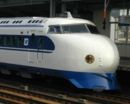 |
|---|---|
| Lines: Tōkaidō • Sanyō • Tōhoku • Jōetsu • Hokuriku • Kyushu
Mini-Shinkansen: Yamagata • Akita • Future lines: Chuo • Hokkaido • Cancelled lines: Narita Trainsets: 0 Series • 100 Series • 200 Series • 300 Series • 400 Series • 500 Series • 700 Series • 800 Series • E1 Series • E2 Series • E3 Series • E4 Series • Export trainsets: 700T Series • CRH2 • Future trainsets: N700 Series • FASTECH 360 |
| High-speed trains | |
|---|---|
| Acela Express • Alfa Pendular • AVE • ETR 500 • Eurostar • InterCityExpress • JR-Maglev MLX01 • HST • Korea Train Express • Magnetic levitation trains • Pendolino • Shinkansen • TGV • Thalys • THSR • Transrapid • Treno Alta Velocità • X 2000 |
ar:شينكانسن ca:Shinkansen cs:Šinkansen da:Shinkansen de:Shinkansen el:Σινκανσέν es:Shinkansen eo:Ŝinkanseno fa:شینکانسن fr:Shinkansen ko:신칸센 id:Shinkansen it:Shinkansen he:שינקנסן ka:სინკანსენი ms:Shinkansen nl:Shinkansen ja:新幹線 pl:Shinkansen pt:Shinkansen ro:Shinkansen ru:Синкансэн war:Shinkansen simple:Shinkansen fi:Shinkansen sv:Shinkansen zh:新幹線
